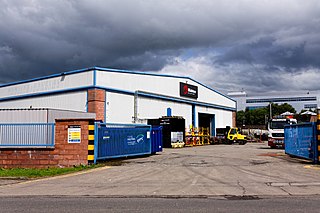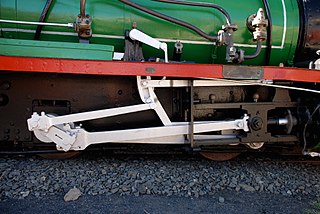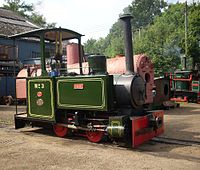
The valve gear of a steam engine is the mechanism that operates the inlet and exhaust valves to admit steam into the cylinder and allow exhaust steam to escape, respectively, at the correct points in the cycle. It can also serve as a reversing gear. It is sometimes referred to as the "motion".

Andrew Barclay Sons & Co., currently operating as Brodie Engineering, is a builder of steam and later fireless and diesel locomotives. The company's history dates to foundation of an engineering workshop in 1840 in Kilmarnock, Scotland.

W. G. Bagnall was a locomotive manufacturer from Stafford, England which was founded in 1875 and operated until it was taken over in 1962 by English Electric.

Alan Keef Ltd is a British narrow gauge railway engineering company which manufactures, overhauls, and deals in narrow gauge locomotives, rolling stock and associated equipment.
Dick, Kerr and Company was a locomotive and tramcar manufacturer based in Kilmarnock, Scotland and Preston, England.

The Baguley valve gear is a type of steam engine valve gear invented by Ernest E. Baguley, the Chief Draughtsman of the W.G. Bagnall company of locomotive manufacturers and patented in 1893. It was used by Bagnall during Baguley's time there, then by his own company of Baguley Cars Ltd.
The Drewry Car Co was a railway locomotive and railcar manufacturer and sales organisation from 1906 to 1984. At the start and the end of its life it built its own products, for the rest of the time it sold vehicles manufactured by sub-contractors. It was separate from the lorry-builder, Shelvoke & Drewry, but it is believed that James Sidney Drewry was involved with both companies.

Bagnall–Price valve gear is a type of steam engine valve gear developed at locomotive manufacturer W.G. Bagnall as an alternative to the more common Walschaerts valve gear and also to supersede the Baguley valve gear their designs had previously utilised. The gear was patented in 1903 by W.G. Bagnall and T. S. Price, the manager of the works.
The Railway Museum at Mysore, India is an outdoor exhibit of vintage locomotives.

Ernest E. Baguley (1863–1948) was a British engineer.

This is a general list of rolling stock and locomotives currently or formerly on the Groudle Glen Railway on the Isle of Man.

The Leighton Buzzard Light Railway (LBLR) is a light railway in Leighton Buzzard in Bedfordshire, England. It operates on 2 ft narrow-gauge track and is just under 3 miles (4.8 km) long. The line was built after the First World War to serve sand quarries north of the town. In the late 1960s the quarries switched to road transport and the railway was taken over by volunteers, who now run the line as a heritage railway.
Six of the only 14 Bagnall fireless locomotives built by W. G. Bagnall of Stafford, England, have been preserved. Brief histories of them are given in this article and they are listed by works number. All are standard gauge 0-4-0s except where otherwise stated.

Doll is a 2 ft gauge 0-6-0T steam locomotive based at the Leighton Buzzard Narrow Gauge Railway in Bedfordshire.

Sea Lion is a steam locomotive built in 1896 to supply the motive power to the Groudle Glen Railway on the Isle of Man and the locomotive still provides the main traction there today. The locomotive was built by W.G. Bagnall & Co., Stafford and delivered to the line in May of that year, providing sole motive power until joined in 1905 by sister locomotive Polar Bear. When delivered to the railway, the locomotive carried an olive green livery with vermilion and yellow lining and the name carried on the side water tank in gold leaf with blue shadowing, with distinctive round "spectacle" cab windows back and front. These were changed over to rectangular windows very early in the engine's career to improve driver visibility however. One distinctive feature was a displacement lubricator mounted atop the highly polished brass dome. The locomotive was fitted with unusual valve gear patented by E.E. Baguley and is one of only four locomotives to remain in existence with this. By the 1920 season the locomotive was deemed too costly for repair and the line purchased two battery electric locomotives that inherited their steam engine names. The modern engines proved to be financially disastrous and within a few years "Sea Lion" had been returned to the works for re-build. It continued to operate the line until closure at the outbreak of the Second World War in 1939.

Polar Bear is a narrow-gauge steam locomotive built in 1905 by W. G. Bagnall for the Groudle Glen Railway. It is now preserved and runs on the Amberley Museum Railway.

Baguley Cars Ltd was a British engineering company, specialising in railway locomotives. it was founded in 1911 by Ernest E. Baguley and subsequently acquired by Drewry Car Co to form Baguley-Drewry in 1964.

Michael Graham Satow OBE, or simply Mike Satow was an engineer who was a key person in railway heritage in India and the United Kingdom. Among other achievements he was pivotal in the establishment of the National Rail Museum, New Delhi, India and creation of a replica of Locomotion No. 1.

Baguley 774 is one of the earliest surviving narrow-gauge internal combustion locomotives. It was built in 1919 for the Timber Supply Department of the Board of Trade. After a varied career, it was preserved at the Narrow Gauge Railway Museum in Tywyn.















